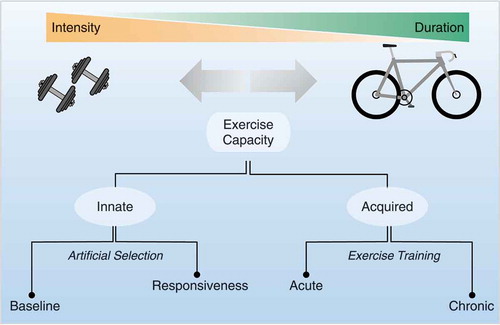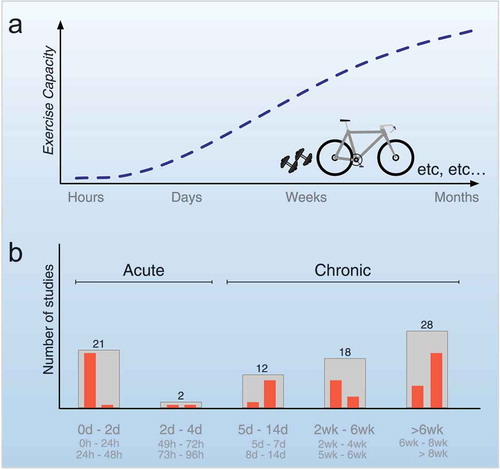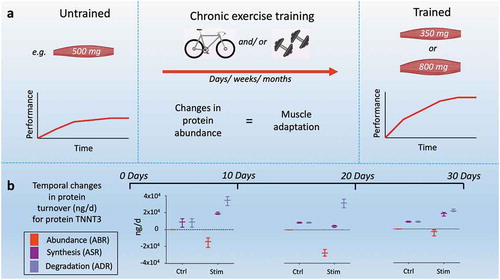Figures & data
Figure 1. The exercise continuum
Exercise stimuli span a continuum from maximal intensity contractions (e.g. associated with heavy weight training) to sustained periods of lower intensity work associated with endurance events. The intensity and duration of each exercise bout are important components that determine subsequent cellular responses and long-term adaptation to training. Indices of exercise capacity, including maximum oxygen uptake (VO2max), muscle force etc., are the result of acquired environment factors (i.e. exercise training) and innate genetic factors that can influence either baseline levels or an individual’s responsiveness to exercise training.

Figure 2. Distribution of proteomic literature over the time course of muscle adaptations to exercise
Adaptations to exercise are dynamic and gains in exercise capacity develop gradually over time (A). Proteomic studies (number of publications) of muscle responses to exercise can be categorized as acute or chronic (B). Acute studies have typically investigated muscle responses within the first 24 h after a bout of exercise. These data offer insight to early adaptive responses but can also be challenging to interpret because they may contain a mix of responses that are associated with restoration of homeostasis as well as signals specific to adaptation. Studies of chronic training have typically investigated samples collected 48–96 h after the cessation of training. This approach helps focus on the outcomes of training and avoid the potentially confounding effects of the last bout of exercise.

Figure 3. The ‘Proteo-ADPT’ method
The Absolute Dynamic Profiling Technique for Proteomics (Proteo-ADPT) enables temporal analysis of the contributions of synthesis and degradation to changes in the abundance of individual proteins. (A) Chronic exercise training over periods of weeks or months confers overt changes in muscle mass, induced by alterations in individual protein abundances resulting in both changes in muscle phenotype and quantitative changes in muscle performance. (B) Proteo-ADPT data from [Citation61] reporting responses of the fast isoform troponin t (TNNT3) during 30 days of unilateral chronic low-frequency stimulation. Absolute (ng/d) data are presented as mean ± SD (n = 3 per group) from stimulated (Stim) and contralateral control (Ctrl) EDL. During the period between 10 d and 20 d CLFS, the rate of change in abundance (ABR) of TNNT3 was 0 ng/d in Ctrl EDL and −27,591 ± 4000 ng/d in Stim EDL. The absolute synthesis rate (ASR) of TNNT3 was not significantly different between Ctrl (8564 ± 690 ng/d) and Stim (4174 ± 1237 ng/d). Whereas the absolute degradation rate (ADR) of TNNT3 was significantly greater in Stim (31,766 ± 5236 ng/d) than Ctrl (8564 ± 690 ng/d) and accounted for the change in TNNT3 abundance.

